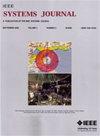具有rce和LO相位漂移的cf - mimo下行性能分析:一种随机几何方法
IF 4.4
3区 计算机科学
Q1 COMPUTER SCIENCE, INFORMATION SYSTEMS
引用次数: 0
摘要
在本文中,我们研究了具有互易校准误差(RCEs)和由于本振(LO)相位漂移导致的不完全相位同步的无单元大规模多输入多输出(CF-mMIMO)系统的系统级性能。考虑到远程无线电单元(RRU)的实际实现以及由于rce和LO相位漂移导致的下行和上行信道的非互易性,我们采用随机相位旋转对下行信道进行建模。然后,我们研究了采用最大比率传输(MRT)和零强制(ZF)预编码方案的集中式和分布式CF-mMIMO体系结构的系统级性能。我们推导了下行预编码方案的信噪比的封闭表达式,并根据泊松点过程获得了RRU和用户设备(UE)位置下每个用户的平均频谱效率(SE)的封闭表达式。仿真结果表明,与蒙特卡罗结果相比,封闭形式的表达式是准确的。结果表明,集中式ZF预编码的rce和LO相位漂移对系统性能的影响比MRT和分布式ZF预编码更严重。此外,我们还揭示了RRU的天线配置、RRU密度、UE密度和本相漂移范围对SE性能的影响。本文章由计算机程序翻译,如有差异,请以英文原文为准。
Downlink Performance Analysis of CF-MMIMO With RCEs and LO Phase Drift: A Stochastic Geometry Approach
In this article, we study the system-level performance of cell-free massive multiple-input multiple-output (CF-mMIMO) systems with reciprocity calibration errors (RCEs) and imperfect phase synchronization due to the local oscillator (LO) phase drift. Considering the practical implementation of a remote radio unit (RRU) and the nonreciprocity of downlink–uplink channels due to RCEs and LO phase drift, we model the downlink channel with a random phase rotation. Then, we study the system-level performance of both centralized and distributed CF-mMIMO architectures with maximum ratio transmission (MRT) and zero-forcing (ZF) precoding schemes. We derive the closed-form expressions for the signal-to-interference-plus-noise ratio of the downlink precoding schemes, and obtain the closed-form expressions for the average spectral efficiency (SE) per user with locations of both RRU and user equipment (UE) following the Poisson point process. Simulation results show that the closed-form expressions are accurate when compared with Monte Carlo results. The results demonstrate that the impact of RCEs and LO phase drift on system performance is more severe for centralized ZF precoding than for MRT and distributed ZF precoding. In addition, we reveal the SE performance concerning antenna configuration of RRU, RRU density, UE density, and LO phase drift range.
求助全文
通过发布文献求助,成功后即可免费获取论文全文。
去求助
来源期刊

IEEE Systems Journal
工程技术-电信学
CiteScore
9.80
自引率
6.80%
发文量
572
审稿时长
4.9 months
期刊介绍:
This publication provides a systems-level, focused forum for application-oriented manuscripts that address complex systems and system-of-systems of national and global significance. It intends to encourage and facilitate cooperation and interaction among IEEE Societies with systems-level and systems engineering interest, and to attract non-IEEE contributors and readers from around the globe. Our IEEE Systems Council job is to address issues in new ways that are not solvable in the domains of the existing IEEE or other societies or global organizations. These problems do not fit within traditional hierarchical boundaries. For example, disaster response such as that triggered by Hurricane Katrina, tsunamis, or current volcanic eruptions is not solvable by pure engineering solutions. We need to think about changing and enlarging the paradigm to include systems issues.
 求助内容:
求助内容: 应助结果提醒方式:
应助结果提醒方式:


